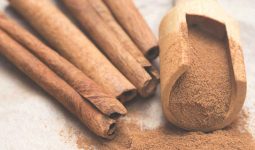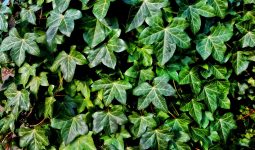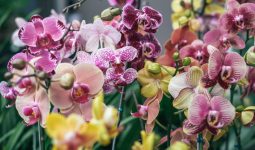There are many different types of shrubs in Florida, and each one requires different methods of care depending on the type of environment you plant it in.
Not leaving the climate zone it’s native to and whether it’s evergreen or deciduous. Moreso, some shrubs need extra water to stay healthy, while others thrive in sandy soils.
In this article, you’ll learn how to care for the most common and different types of shrubs in Florida so you can grow them easily!
1. Viburnum
This is the first of the different types of shrubs in Florida. Viburnum, also called arrowwood, is a genus of about 150 species of woody plants in the family Adoxaceae.
They are native to temperate regions of North America, Europe, Asia, and Africa. Most are deciduous trees or shrubs, but some are herbaceous perennial subshrubs.
One specimen located in New York is estimated to be 5250 years old! It is one of the oldest different types of shrubs in Florida.
2. Thunbergia
The second on the list of different types of shrubs in Florida is Thunbergia. Its deeply lobed, glossy green leaves are studded with clusters of small, starry blooms.
This perennial does best in filtered sunlight or partial shade. Remove spent blooms immediately for a continuous show-through fall.
Further, Thunbergia requires moist, organic-rich soil. So be sure to amend planting beds with compost before adding soil amendments such as peat moss or perlite.
Thunbergia needs regular watering during dry spells and thrives during wet winters. They’re typically hardy up until zone 8b.
For an easy-care solution that thrives year-round indoors, try growing thunbergia in a large container filled with coir fiber. It will require watering only once every two weeks or so.
3. Croton
This is also one of the different types of shrubs in Florida is Croton. It was introduced in Florida before 1900.
The plant is an excellent choice for urban landscapes because it’s a fast-growing shrub that tolerates drier conditions than many other trees and plants.
Also, once established, croton can survive with as little as one inch of rainfall a month. It also tolerates heat better than most other shrubs.
And this makes it a good choice if you live where temperatures regularly reach 90 degrees F or higher.
4. Crown of Thorns
Most people are familiar with Crown-of-Thorns since they are commonly grown as houseplants. This succulent plant is easy to take care of, although it’s not necessarily attractive.
However, if you have an area where plants need little water or other attention, growing crown-of-thorns might be a good idea. Keep reading below for more information on Florida’s different types of shrubs.
5. Coontie
Coonties grow abundantly in wet areas. They have green leaves, which can be either evergreen or deciduous and small yellow flowers that look like buttercups.
While all coontie plants are considered herbaceous perennials, some live for as many as 20 years.
Moreover, the plant can tolerate full sun and partial shade, but it grows best when planted in moist soil that receives plenty of moisture through rain or irrigation.
Coontie makes an attractive ornamental landscape element with a tropical flair when cultivated correctly.
6. Boxwood
Like some of the different types of shrubs in Florida, these shrubs require good sunlight and soil. The soil should be well-drained, with moderate levels of pH.
The Boxwood can handle cold temperatures but can’t withstand extreme heat or high humidity levels.
These shrubs grow best when they’re placed along a wall or fence. However, they can be easily trimmed and have been used as hedges in gardens. Keep your boxwood trimmed to maintain its shape.
In addition, you should give your plants a full soaking once every two weeks during the hot summer months so that their root systems will stay healthy.
You might want to cover your Boxwood during winter months (up north) if you live somewhere with mild winters. This is major because these plants are sensitive to frost damage.
7. Blue Porterweed
Blue Porterweed (Eupatorium purpureum), also known as Joe Pye weed, is an herbaceous perennial plant that produces purple flowers on top of white stems.
This plant grows slightly over 2 feet tall, with large oval-shaped leaves. These can range between 3-6 inches long.
During mid-summer, these plants grow large clusters of blue flowers that look like flags waving in the wind. Butterflies, honeybees, and beetles pollinate these flowers.
How do you use blue porter weed? Floral arrangements, jams, or pies are a few ways to use these plant parts. A multipurpose plant, right? That’s one out of many other different types of shrubs in Florida!
8. Hibiscus
Next on my list of different types of shrubs in Florida is Hibiscus. It is a very easy flower to grow. I have grown these myself, and they are not hard at all.
Likewise, there are many varieties, like yellow, white, red, and pink. They add a tropical feeling to your garden.
Be careful when planting because they don’t take well to cold temperatures, so wait until spring/summer before planting one.
Also, it will grow tall, but it has nice side branching, so it grows wider too. This plant is not hard at all to maintain, so if you need something that requires little work, then I recommend one of these!
9. Ixora
Of the different types of shrubs in Florida, the Ixora is a very popular flowering one. It grows in clusters and has small, purplish-black or red flowers with five petals.
Ixora’s are hardy plant that grows well outdoors year-round, but they do best when exposed to full sun.
Furthermore, they can be trimmed into hedges, topiaries, or left as tall trees with drooping branches ideal for hanging baskets.
Plant them in rich soil and water once per week, especially during periods of drought; too much water can cause rot. Prune regularly during spring or summer after the danger of frost has passed.
Also, you can prune while they are dormant in winter if you see dead branches. Or whenever pruning is needed because they have outgrown their space.
10. Knock Out Rose
A popular variety of garden roses, Knock Out Rose is disease-resistant and grows fast. Also, it offers beautiful clusters of dark red blooms from spring through fall.
While easy to maintain, Knock Out Rose needs full sun exposure because it thrives on neglect. However, it’s not necessary to fertilize or prune.
Hardy in U.S. Department of Agriculture zones 7 through 10, it does best when planted near a fence or trellis.
This is because its branches tend to sprawl outward. It’s also appropriate for large containers or raised beds in climates where winters are mild (Zone 6).
11. Ligustrum
Ligustrum is a genus of around 40 species of deciduous and evergreen shrubs. The leaves are alternate, simple, ovate-acute, 0.5-2 x 1–3 cm (rarely 5 cm) long, with an entire or serrate margin.
They are often much larger than those of members of its sister genus Bohonanthus. The flowers are produced on long racemes; they have 4 petals and 6 stamens with long filaments.
Meanwhile, the Ligustrum is sometimes called Asian privet or Korean privet. This is also easier to cultivate compared to Florida’s other different types of shrubs.
12. Loropetalum
Proceeding on our list of different types of shrubs in Florida, we have Loropetalum. This is a flowering evergreen shrub that is native to Asia.
Most loropetalum trees grow well in USDA zones 8 through 10, but some varieties are hardy down to zone 6 or 7.
Pruning loropetalum will promote new growth. This is necessary since it tends to lose its leaves annually from late winter through early spring.
The leaves have a bitter taste and smell similar to citrus fruits. While they can be eaten raw, most people only eat them cooked due to their intense flavor.
In addition to eating loropetalum berries raw or cooked, many people make tea with loropetalum berries and use these berries as medicine.
13. Nandina
Nandina Domestica, also known as heavenly bamboo, sacred bamboo, or celestial bamboo, is a species of Nandina Domestica.
It is one of three species that are commonly called heavenly bamboo, though it is not actually related to true bamboo (Bambusa).
In other languages, it may be referred to as: heavenly bamboo tree; sacred bamboo tree, celestial bamboo (Chinese); Heiliger Bambus (German); Nàndines rogenes (Catalan), or simply nandinas.
It grows about two feet per year. The first three years see little or no growth, after which there can be up to six inches per month during the spring and summer months.
14. Cestrum Nocturnum
Cestrum nocturnum (Jasmine) is a vine that, with proper pruning, can become an attractive trellis or pergola.
The fragrant white jasmine flowers appear at night, perfuming your garden without affecting nearby plants. This plant requires yearly pruning, so it doesn’t grow too large and overwhelm other plants.
The Cestrum vine blooms once a year before dying back. Although there are dozens of different varieties, Cestrum nocturnum is hardy only in U.S. Department of Agriculture zones 8 through 10.
Thus, it is unsuitable for growing as a potted indoor plant anywhere in south Florida or Hawaii. We aren’t through with our list of different Florida shrubs types. Don’t stop reading.
15. Hope Philodendron
Hope philodendron (Philodendron oxycardium), a trailing, vining plant with heart-shaped leaves, is another variety of the different types of shrubs in Florida.
It is planted close to a wall or fence where it can spill out and grow horizontally. At least three hours of direct sunlight is recommended.
It has an attractive ground cover because it doesn’t mind dappled light, humidity, or temperatures between 60 degrees Fahrenheit and 90 degrees Fahrenheit.
Even though it thrives outdoors in U.S. Department of Agriculture plant hardiness zones 10b through 11, you can also train your hope philodendron as a houseplant if you have room.
16. Variegated Pittosporum
Checking out the different types of shrubs in Florida, be aware that Pittosporum tobira is known as variegated pittosporum.
The leaves of this plant are variegated with white streaks or bands. This plant will thrive in full sun but if your yard does not receive a lot of sunlight, place your plant near a south-facing window.
Additionally, you can prune off leaves every other year or so to promote growth. The height is usually about two feet tall, but it can grow taller if there is no competition from other plants nearby.
17. Star Jasmine
Star Jasmine (Trachelospermum jasminoides), one of the different types of shrubs in Florida, grows as a deciduous flowering vine.
It is one of many plants cultivated as an indoor ornamental. A houseplant may be small, but it still requires some maintenance.
However, regular watering and fertilizing is the best way to take care of your star jasmines. Like most plants, star jasmines are like moist soil rich in nutrients.
Be sure you aren’t overwatering your plant or letting its roots sit in water. Either situation can lead to root rot, killing your plant quickly.
18. Gardenia Bush
Gardenia Bush Gardenias are members of the coffee family, Rubiaceae. They are medium-sized, evergreen shrubs that can grow up to 10 feet tall. Gardenia bushes grow best in warm weather with mild winters and moist soil.
However, if you want a gardenia bush asides from other different types of shrubs in Florida, you should check that it is hardy to your zone before planting it outside.
In cold climates, gardenias can be grown indoors; however, they require extra winter protection when they are left outdoors.
Most gardenia varieties only flower once during their lifetime; no more flowers will form on that particular bush after flowering.
Though planting several different varieties of gardenias together will help ensure continuous blooming throughout your yard if one variety stops blooming or dies altogether.
19. Firespike
Next to be discussed as part of the different types of shrubs in Florida is Firespike. It is also known as toothache bush.
It is a vigorous evergreen ground cover featuring small spikes of white flowers that form on tall stems above deep green foliage.
Plus, these are very effective as hedges and create an excellent privacy fence. Fire spikes should be planted 6 inches apart with 10-foot spacing between rows when used as a hedge.
This plant grows in the sun or light shade. Moreso, Firespike blooms profusely when planted near crape myrtles (Lagerstroemia).
These flowers, at the same time, create a stunning effect all season long. This ground cover needs very little maintenance once established.
It may need to be trimmed every few years only if you want it to keep its compact shape or if you add new plants nearby.
20. Firebush
Firebush is a deciduous shrub with brilliant orange flowers that is hardy in zones 6-9. These low-maintenance plants are drought tolerant, making them an ideal choice for xeriscaping. They also handle poor soil conditions.
Also, once established, firebush can grow as tall as 15 feet (4.5 meters) but can easily be pruned down to size if desired.
Firebush blooms from April through June when grown in USDA plant hardiness zones 8-10, although it may bloom earlier or later.
It depends on temperature and growing conditions. This is one of the low-budget plants on Florida’s list of different types of shrubs.
21. Allamanda Bush
Allamanda, or yellow allamanda, is a species of flowering shrub native to Brazil. The plant produces racemes with fragrant, bright yellow flowers that are attractive to butterflies.
Allamanda plants grow about 2 feet (60 cm) tall and wide. This makes them suitable for growing in containers or as border plants around larger garden beds.
In addition, these plants require regular watering, so it’s important that they get plenty of suns while being protected from strong winds.
After flowering at its peak during spring through summer, allamanda can continue providing interesting foliage. Also, it provides new blooms throughout the fall into winter months if given proper care.
22. Angel’s Trumpet
The angel’s trumpet, or bupleurum, is a tropical plant and is on the list of different types of shrubs in Florida.
The plant has bright orange flowers that hang from an erect stalk. It can grow up to seven feet tall and has leaves with pointed tips.
It’s hardy enough for gardeners in U.S Department of Agriculture zones 9 through 11 and is drought tolerant, although it grows best when watered regularly.
Angel’s trumpet requires full sun and well-draining soil with a pH between 6.1 and 7.5. Its stiff branches don’t bend easily, which makes it good as a border plant, but its height might overpower smaller specimens planted nearby.
23. Schefflera Arboricola
The Schefflera Arboricola is a fast-growing tree that produces large colorful leaves on bare stems. It is also known as Umbrella Tree or Hardy Kaffir Lime. This tree can grow between 15–30 feet tall, making it a good indoor plant.
Also, the Schefflera Arboricola is a popular houseplant because its unique leaf markings are very eye appealing. You will want to keep your tree inside because it does not tolerate cold weather or frost.
When you plant your tree outside, try to do so during late spring or early summer when soil temperatures reach at least 70 degrees Fahrenheit (21 degrees Celsius).
That way, your new tree has plenty of time to acclimate before winter arrives. Isn’t it such a wonderful species as a part of Florida’s different types of shrubs?
24. Azalea
Azaleas are beautiful flowering shrubs. They require well-drained, acidic soil with ample moisture. Azaleas grow well in shady areas but can also grow fairly well with full sun exposure.
Meanwhile, considering the different types of shrubs in Florida, if you choose to plant azaleas, keep in mind they require regular pruning to maintain their shape and size.
They do not do well when pruned poorly because it can ruin the plant’s ability to bloom properly or at all.
Azaleas prefer being pruned from early spring until early summer; otherwise, growth will be slow on your plant throughout summer. This is bound to happen due to a lack of nutrients.
Like most plants, azaleas need fertilizer as a form of nourishment every year for optimal growth. However, too much can have adverse effects as well!
25. American Beautyberry
Now let’s talk about one of the most adorable plants amongst other different types of shrubs in Florida; the American Beautyberry (Callicarpus americanus).
This is a flowering shrub that can grow up to ten feet tall. The edible berries are dark purple, round, and about half an inch wide.
Seeds, air-layering, or transplanting can propagate American beautyberries. There are both male and female plants.
The males are preferred because they produce abundant fruit sets when planted together with females.
However, if a particular cultivar doesn’t have either a male or female designation on its tag, you will have to plant several seedlings close together.
26. Bougainvilleas
Bougainvilleas are tropical plants that belong to a group called weeping bougainvilleas. They come in various colors, including shades of orange, red, purple, and pink.
They can also be divided into smaller categories based on what color flowers they produce: white bougainvilleas, yellow bougainvilleas, and pink-flowered ones.
Furthermore, Bougainvilleas do best when planted near sunny areas with well-drained soil that isn’t too wet but rich in nutrients.
To help keep your bougainvillea healthy, water it deeply once or twice weekly during the summer months. Otherwise, you should allow it to dry out between watering intervals.
The occasional fertilizer application every few weeks during summer months also helps your plant flourish.
27. Buddleia
Buddleia is a genus of flowering plants in the family Apocynaceae, subfamily Asclepiadoideae. It comprises 140 species of shrubs and small trees.
They form part of a tropical plant family commonly called butterfly bush because many species attract butterflies.
In addition, some species grow as trees reaching 13–15 meters tall with stout trunks, but some are herbaceous plants only reaching 45 centimeters high.
Also, we have other genera containing similar-looking plants that are sometimes mistaken for true Buddleja. They include Lonicera (honeysuckle), Styrax (American snowbells), and Decumaria (silk tassels). Talking about the different types of shrubs in Florida, Buddleia is also very amazing.
28. Cape Jasmine
The beauty and fragrance of cape jasmine make it a fine addition to any garden and, coupled with that, one of the best of the different types of shrubs in Florida.
A member of the Rutaceae, or Rue family, cape jasmine (Gardenia jasminoides) is an upright evergreen shrub.
Plus, in some countries, its fragrant blooms are used in potpourri sachets or herbal medicine. The Cape Jasmine will thrive with minimal attention as long as it gets sun every day.
29. Chenille Plant
The chenille plant is known as a weed but also makes excellent ornaments. The most common varieties are Euonymus japonicus var. ‘Microphyllus’, with small green leaves, and Euonymus japonicus var. macropterous, with large reddish-brown leaves.
Also, the latter grows into a small tree if it has room to spread out; otherwise, you may have to trim back its runners every year or two.
Most varieties feature attractive silver-gray bark that peels off like papier-mâché—this means it’s a chenille plant! Looking for a low-maintenance plant on the list of different types of shrubs in Florida? Consider the Chenille plant!
30. Cocoplum
What is Cocoplum? Cocoplums are a rare fruit tree native to South Florida but available at nurseries across central and south Florida.
The cocoplum shrub produces small oval fruits with a sweet but tart flavor, making them a popular ingredient in juices.
Despite their name, which means coconut plum in Spanish, cocoplums do not contain any actual coconut or plum.
The melon-sized fruit is actually a drupe, like apricot or peach. Its pinkish-white flesh surrounds one or two large brown seeds.
31. Copperleaf
To end the list is Copperleaf. This is a very adaptable plant that is able to thrive almost anywhere as long as there are at least six hours of sunlight per day.
This attractive plant can grow up to 5 feet tall and 3 feet wide. Because it grows so quickly, it’s best used as an accent instead of a background plant or hedge.
The copper-colored leaves are only present during the spring and summer months. But don’t worry—the plant will produce vibrant green leaves all year round.
Conclusion
When starting your landscaping project, it’s important to know Florida’s different types of shrubs to create the look you want.
But you don’t want to choose any type of shrub just because it’s cheap and available; you also want to ensure that it will thrive in your environment, even if that means spending more on pricier options. We hope this article helps!








